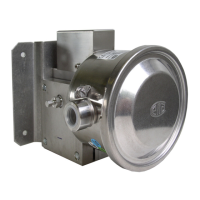6.2 CALIBRATION CIRCUIT AND OPERATIONS
Prepare the calibration circuit as indicated in Fig.3.
The warning lamps should be connected to contact 1 or 2 in the
NO or NC position according to the required contact action.
Connection of C and NO terminals
• If the circuit is open at the working pressure, the switch closes
the circuit as the pressure increases when the desired value is
reached.
• If the circuit is closed at the working pressure, the switch opens
the circuit as the pressure decreases when the desired value is
reached.
Connection of C and NC terminals
• If the circuit is closed at the working pressure, the switch opens
the circuit as the pressure increases when the desired value is
reached.
• If the circuit is open at the working pressure, the switch closes
the circuit as the pressure decreases when the desired value is
reached.
The pressure switch must be mounted in the normal installation
position, i.e. with the pressure connection pointing downwards.
Avoid forcing the elastic support of the microswitch by hand or
with tools. This could affect the instrument functioning.
CAUTION: if the switch is of the kind with adjustable dead band
(letter R in the contact codes) before proceeding with the
following operations it is necessary to proceed with the
adjustment of the dead band.
Increase the pressure in the circuit up to the desired set point
value for the first microswitch. Use a wide bladed screwdriver, as
indicated on the label, turn the screw until the relative lamp turns
on (or turns off).
- If the instrument is equipped with only one contact the
calibration is complete.
- If it is equipped with two contacts continue in the following
manner. Vary the pressure until the desired set point value for
the second microswitch is reached. Act on the adjustment screw
of the second contact.
Repeat calibrating operations on the first contact, then on the
second contact, until the required set point accuracy is obtained.
This is necessary due to the reciprocal influence which the
microswitches have on the sensitive element of the instrument.
CAUTION: if the two set point are different they must be different
for much of 5% of the adjustable span.
6.3 CHECK OF SET POINT
Generate the normal working pressure and wait the pressure
stabilisation. Vary the pressure into the circuit and record the set
point value. Write the set point values on the adhesive label.
Note: the repeatability should be checked verifying for three
times the set point (Pi) starting always from the same pressure
value (Pw). The pressure cycle should be slowly to give the
possibility to record the set point with accuracy.
6.4 CALIBRATION CIRCUIT FOR INSTRUMENT WITH
ADJUSTABLE RANGE LESS TO 60 mbar
The calibration circuit used for the calibration of these
instruments must be:
- of big internal volume (5 liters or bigger) in order to reduce the
effect of volumetric variation (and therefore of pressure) caused
by the sensing element of the pressure switch during the snap
action.
- in a thermally stable place in order to guarantee stability to the
pressure inside the circuit used for the calibration.
Have to be considered that in a closed circuit with the internal
pressure equal to the atmospheric pressure, the variation of
temperature of 1°C causes in the circuit a pressure variation of
3,4 mbar.
The maximum inlet pressure must not exceed the lesser of
overpressure allowed by the pressure switch and the test gauge.
The test instrument should have a measurement range
approximately equal to or slightly wider than the pressure switch
range and should have an accuracy consistent with the accuracy
required to calibrate the set point.
For example DW10 range 0..16mbar the accuracy of the test
gauge must be ± 0,04 mbar to calibrate the set point with an
accuracy of ± 0,16 mbar (1% of the adjustable span).

